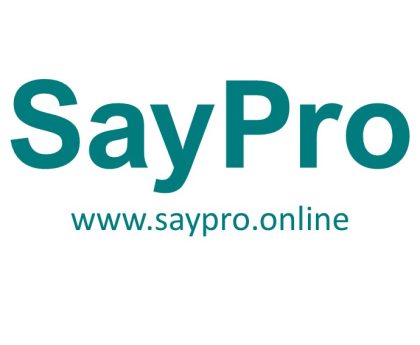SayPro Refine Existing Filters Review and refine existing filters to ensure they continue to meet the needs of customers by 01-15-2025 from SayPro Monthly January SCMR-17 SayPro Monthly Categories and Filters: Organize listings into categories with filters for easy navigation by SayPro Online Marketplace Office under SayPro Marketing Royalty SCMR
As part of the continuous effort to enhance the user experience on the SayPro online marketplace, it is crucial to review and refine the existing filters to ensure that they continue to meet the evolving needs of customers. Filters are an integral part of the browsing and shopping process, helping customers quickly narrow down product choices based on relevant attributes. Over time, customer needs, product offerings, and market trends change, so periodic review and refinement are necessary.
This task is to be completed by 01-15-2025 and involves analyzing the current filter setup, gathering customer feedback, identifying potential areas for improvement, and implementing updates to the filtering system to improve ease of use, accuracy, and sales conversion.
1. Review Current Filter Setup
Objective:
To evaluate the current filters in place and identify any gaps, redundancies, or opportunities for optimization based on customer behavior, product changes, and marketplace trends.
Tasks:
- Identify Existing Filters: List all the current filters available on the platform (e.g., price range, brand, size, color, rating, material).
- Assess Filter Relevance: Check whether all existing filters are still relevant and necessary. For instance, if a product category has seen a significant increase in options, additional filters may be required.
- Evaluate Filter Usage: Use data analytics to analyze which filters customers use most often, and which filters are rarely selected or have low engagement. This data will help decide which filters need enhancement or removal.
- Check for Redundancy: Ensure there are no redundant filters that confuse customers or create a cluttered interface (e.g., two similar filters for color or size).
Timeline:
Complete review by 01-10-2025.
2. Gather Customer Feedback
Objective:
To collect qualitative and quantitative feedback from customers to understand their pain points, needs, and expectations regarding filters and categorization.
Tasks:
- Customer Surveys and Polls: Launch surveys on the platform or through email to ask customers about their filter experience. Include questions about filter accuracy, usefulness, and ease of use.
- Monitor Customer Service Feedback: Review support tickets and queries related to filtering issues. Identify common complaints or suggestions related to filtering.
- Social Media and Reviews: Monitor social media platforms and product reviews to see if customers mention problems or challenges with the filtering system.
- User Testing: Conduct usability tests with a group of real users to observe how they interact with filters and identify any pain points in the process.
Timeline:
Feedback collection completed by 01-05-2025.
3. Analyze and Identify Key Areas for Improvement
Objective:
To assess the gathered data and feedback to identify areas where existing filters could be improved or new filters could be added to enhance user navigation and improve the shopping experience.
Tasks:
- Customer Needs Analysis: Based on feedback, identify missing filter options that customers would find valuable. For example, adding filters for “Eco-Friendly,” “New Arrivals,” or “Best Sellers” if they align with customer demand.
- Cross-Category Analysis: Ensure that all product categories have filters that are relevant to their specific attributes. For example, the “Clothing” category may need additional filters like “Material,” while “Electronics” might need filters for “Warranty” or “Features.”
- Performance of Existing Filters: Analyze the effectiveness of existing filters by looking at metrics such as click-through rates, abandonment rates, and conversion rates tied to filtered results. Filters that lead to higher sales conversions or engagement should be prioritized.
Timeline:
Complete analysis and identification of improvements by 01-10-2025.
4. Refine and Implement Filter Updates
Objective:
To refine the existing filter structure and implement the necessary updates, ensuring that the filtering system remains aligned with customer expectations and product catalog changes.
Tasks:
- Modify Filter Labels: If customer feedback indicates confusion with the current filter labels (e.g., unclear terms), update them to be more intuitive and easy to understand.
- Add New Filters: Introduce new filters based on the identified needs, such as new product categories or updated trends (e.g., sustainability, eco-friendly options, etc.).
- Rearrange Filter Options: Optimize the order of filters based on customer behavior. High-priority filters should be placed at the top for easy access (e.g., “Price” and “Brand” filters are often among the most used).
- Optimize for Mobile: Ensure that all updated filters are fully optimized for mobile devices, considering that a large portion of traffic comes from smartphones and tablets.
- Improve Filter Functionality: Enhance the logic behind the filters so they work more seamlessly, such as enabling multi-selection for size or color or improving the accuracy of search results based on applied filters.
Timeline:
Filter refinement and updates to be implemented by 01-12-2025.
5. Test New Filters and Monitor User Feedback
Objective:
To test the newly implemented filters and gather real-time feedback to ensure that the changes are effective in improving the user experience and sales outcomes.
Tasks:
- Conduct Internal Testing: Before the filters are rolled out to all customers, test the new filter setup internally to ensure that the changes work smoothly and that filters are applied correctly across the platform.
- Pilot Testing with Customers: Introduce the updated filter system to a select group of users and gather their feedback to ensure that it aligns with their expectations.
- Monitor Analytics: Use analytics tools to monitor the performance of the newly implemented filters, including usage rates, engagement levels, and conversion metrics.
- Adjust as Necessary: Based on the feedback and performance data, make any additional adjustments to the filters to further refine the user experience.
Timeline:
Testing and monitoring to be completed by 01-15-2025.
6. Training and Documentation
Objective:
To ensure that internal teams understand the changes made to the filter system and can effectively communicate the updates to customers.
Tasks:
- Update Documentation: Revise the internal documentation for the filter system to reflect the newly added or modified filters and explain their usage.
- Team Training: Conduct training sessions for customer support, marketing, and product teams to ensure they are aware of the new filters and how they benefit customers.
- Create User Guides: Develop and publish user guides or tooltips on the platform to educate customers on how to use the new and improved filters effectively.
Timeline:
Complete training and documentation by 01-15-2025.
7. Final Review and Reporting
Objective:
To review the completed work, evaluate the effectiveness of the refinements, and report on the impact of the changes.
Tasks:
- Evaluate Success Metrics: Assess how well the refined filters have performed in terms of user engagement, satisfaction, and sales conversion rates.
- Prepare Final Report: Compile a comprehensive report detailing the changes made, customer feedback received, and measurable outcomes.
- Report to Management: Share the final report with key stakeholders to highlight the improvements made and suggest any additional refinements based on ongoing monitoring.
Timeline:
Final review and reporting by 01-15-2025.
Conclusion:
By 01-15-2025, SayPro will have completed the refinement of its existing filters, ensuring that they remain relevant, intuitive, and effective for users. This will enhance the customer shopping experience, improve navigation on the platform, and ultimately increase sales conversion rates. Through continuous review, customer feedback, and data-driven improvements, the filtering system will be more in line with customer needs and expectations, fostering greater engagement and satisfaction.



